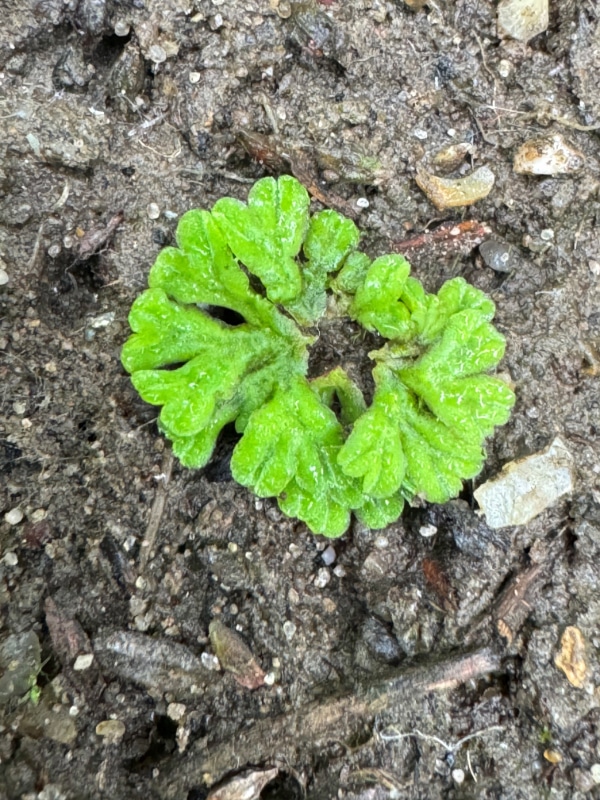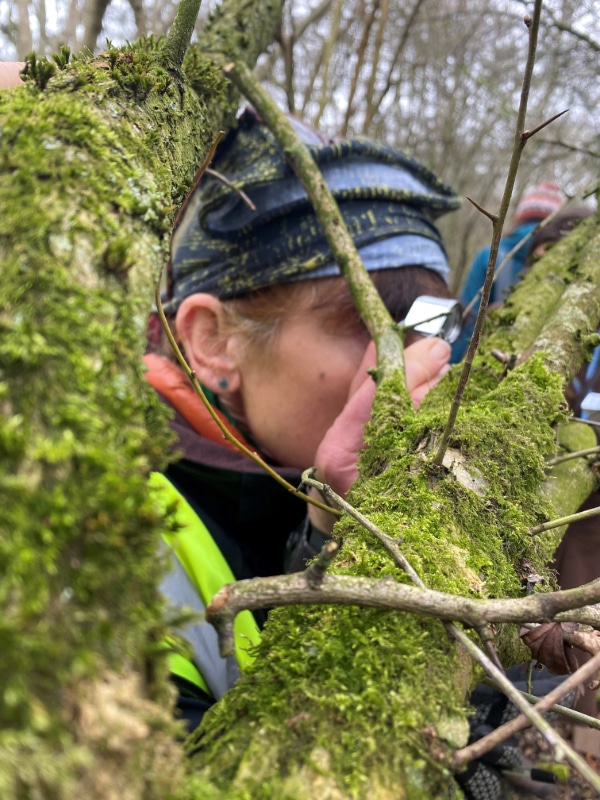Discovering Mosses from Haringey to London’s Urban Wildness
Cassandra Li – Conservation Ecologist & Bryologist in Training
Committed to weaving biodiversity into the urban fabric, hand in hand with the community, I currently work as Team Leader at The Conservation Volunteers (TCV). You will often find me tending to the charming nature spaces in Haringey, or studying bryophytes, spiders and other wildlife around London.

Bryophytes, comprising mosses, liverworts, and hornworts, may be diminutive in stature, but they play a crucial role in the ecological tapestry. And luckily for us Londoners, there is a surprisingly diverse bryoflora right at our doorstep. It’s easy to find the minute rainforests of mosses against the bustling backdrop of the metropolis. My exploration of bryophyte recording began at the enchanting oasis known as The Paddock Community Nature Park in Haringey, and has since expanded to various corners of London.
The Paddock
In the heart of Tottenham Hale’s vibrant urban landscape, 22 people are hunched over, eyes locked onto a tiny green patch – some even busting out hand lenses. This is a snapshot of a moss recording session I organised in December 2023 at the Paddock, a triangular scrub and secondary woodland surrounded by Lea River navigations.
Guided by the experienced bryologist Jeff Duckett, we meticulously observe the subtle differences of the colours and shapes of the leaves, the branching patterns, and the number and details of the sporophytes. As primitive land plants, mosses and liverworts don’t have roots, flowers, or fruits. Yet there are over 1000 species in Britain. The charismatic Thamnobryum alopecurum (Fox-tail Feather-moss)is a new species to the Paddock found in our survey. The unique tree-like shape, namely a bare dark stalk under a bushy crown, is unmistakeable. And, like tumbleweed, this moss can detach itself from the ground and roll around!


Thamnobryum alopecurum (Fox-tail Feather-moss)
Identifiable from afar is the bright green Cryphaea heteromalla (Lateral Cryphaea) with ‘branches’ sticking out horizontally. This is a species returning to London after the Clean Air Act 1956 and 1968. Bryophytes, sensitive to changes in the environment, are excellent indicators of ecological health.
Other personal encounters with these tiny botanical treasures have been nothing short of magical in this brisk winter morning, from stumbling upon the adorable velvety cushions of Grimmia pulvinata (Hedgehog Moss) to marvelling at the translucent beauty of Fissidens taxifolius (Common Pocket-moss) after a refreshing rain, from discovering the vibrant golden green hues of Homalothecium sericeum (Silky Wall Feather-moss) on a brick wall to exploring the delicate feather-like foliage of Kindbergia praelonga (Common Feather-moss) on the woodland floor.


A later look under the microscope reveals springtails, worms and many other invertebrates live in the mosses. It is always a delight to find the orange Octospora music-muralis, a bryophilous fungi on Grimmia pulvinata. The unique structure and moisture-retaining property of bryophytes create microhabitats, which even in the colder months play host to a bustling community of life.
As we drew our session to a close, the volunteers made the first sighting of Marchantia polymorpha subsp. ruderalis (Common Liverwort) on site. Nestled within the tile crevices just adjacent to the offices, the liverwort is unnoticed until now. In a wonderful testament to the joy of recording, we discern the overlooked beauty, unlocking an unexplored microcosm. In total, our moss excursion for 2023 revealed 33 bryophyte species, adding five newcomers into the 2022 list.
London
In my second year of studying bryophytes, the scientific names finally start to make sense and I am more confident to share my knowledge of the common and distinctive species with others. The best way for me to improve recording skills is going outdoors on field trips and observing mosses or any taxa in their habitats. Achieving this is only possible with the incredible support of a community of bryophyte enthusiasts from the British Bryophyte Society (BBS) and London Natural History Society (LNHS), particularly Jeff, who generously shares his extensive knowledge cultivated from over 60 years of studying bryophytes in London.
Among all the locations of our field excursions, Hampstead Heath stands out for me as a haven for a diverse array of bryophytes, ranging from the common Tortula muralis (Wall Screw-moss) and Metzgeria furcata (Forked veilwort) to Sphagnum (bog mosses). Immersing ourselves in this enchanting microscopic realm, we easily lose track of time. It is not uncommon to spend the first half hour or so of any field trip just exploring the mosses in the car park at the meeting point. Darland’s Lake Nature Reserve in Barnet, and Queens Wood, an ancient woodland in Haringey, are also unique habitats to find intriguing mosses and liverworts. Local sites like Alexandra Park and Railway Fields Nature Reserve give me the opportunity to witness the life cycle and transformations over the years. Despite the abundance of bryophytes in Britain, much less is known about them in comparison to the flowering plants and ferns.
Equally captivating is the City of London, where the London BBS group spotted a colony of Riccia sorocarpa (Common Crystalwort), a rare liverwort in London, inside two raised flower beds close to Tower Hill tube station. Plus, explorations in such a busy spot often prompts curious passersby to inquire, ‘What are you looking at?’, offering a perfect opportunity to share our passion for these microscopic green gems. Appreciating and recording mosses doesn’t require a dedicated day in green spaces, even rare species can be found within the routine of everyday life. Picture this: you are trudging through this dreary winter day, surrounded by cold concrete and the city hustle. Yet, pause for a moment, you’ve zoomed in and noticed the five different moss species, each of a different shade of green on a mundane wall, some adorned with delicate drooping capsules on a thin red stalk. Now, the same moment is transformed into a remarkable experience of mindfully connecting with nature.


Contributions to GiGL:
Since 2021, my colleagues at TCV and I organise regular wildlife survey sessions and species recording workshops in Haringey, totalling over 200 sessions for more than 1300 participants. A recurring question from the volunteers is ‘Where do the data go?’. The significance of submitting data to GiGL, contributing to broader nature recovery initiatives, is crucial for many volunteer recorders. This is because detailed ecological data are essential for evidence-based decision-making and the implementation of robust actions. Long-term volunteers from the wildlife survey projects have provided the following quotes on joy of recording:
‘The value and joy I get from taking part in wildlife surveys is not only in developing my ID skills but appreciating the changes in species numbers and diversity through the seasons and also in making an active, positive contribution to a conservation project.’ – Amanda
‘I so appreciate the opportunity to take part in the wildlife surveys for The Conservation Volunteers each week as they give me a lot of joy, new knowledge every time, a feeling of making a contribution and of being part of a community.
Hearing the gentle sound of a tiny goldcrest, catching sight of a bright yellow brimstone butterfly or looking closely at the markings on a leopard slug is both calming and joyful and opens our heart to the magnificence of nature wherever we live.’ – A TCV volunteer
‘I’ve loved taking time out to focus in on details I might not have noticed before, like the different structures of spiders’ webs, or the flight patterns of butterflies.’ – Carrie
‘I really enjoy the bird surveys. The leaders are very welcoming, and I enjoy spending time with a group of likeminded people. On the surveys we all share information and knowledge to identify birds and bird song and take great pleasure in what we see and hear. I have learned a lot and continue to do so and feel pleased our surveys contribute to our local knowledge of the patterns and changes in local birdlife.’ – Liz
Recording fosters an intimate understanding of the natural wonders surround us. From this understanding comes genuine care. And from this care emerges meaningful actions for nature.
The significance of individual contributions to this collective understanding of urban biodiversity cannot be overstated; every observation, every record, adds a valuable brushstroke to the canvas of ecological knowledge. I invite you to discover the hidden treasures of our local habitats and become an integral part of the ongoing conservation efforts.
See you at the field trips and wildlife surveys!
Field Trips Opportunities in London:
London Bryophyte Group Archives – British Bryological Society
London Natural History Society – Full programme (lnhs.org.uk)
Useful information:
Getting started with bryophyte: Getting started – British Bryological Society
Bryophilous fungi: Guide to common bryophilous fungi – British Bryological Society
Book: Gathering Moss -A Natural and Cultural History of Mosses by Robin Wall Kimmerer


